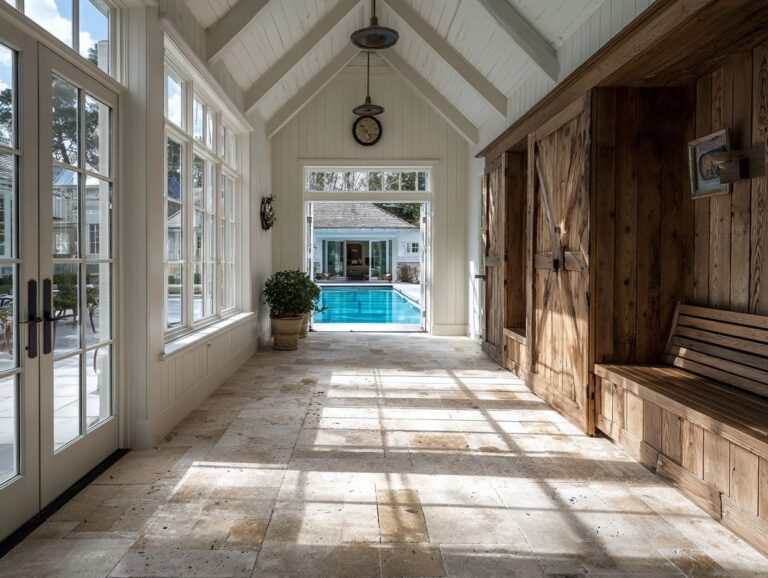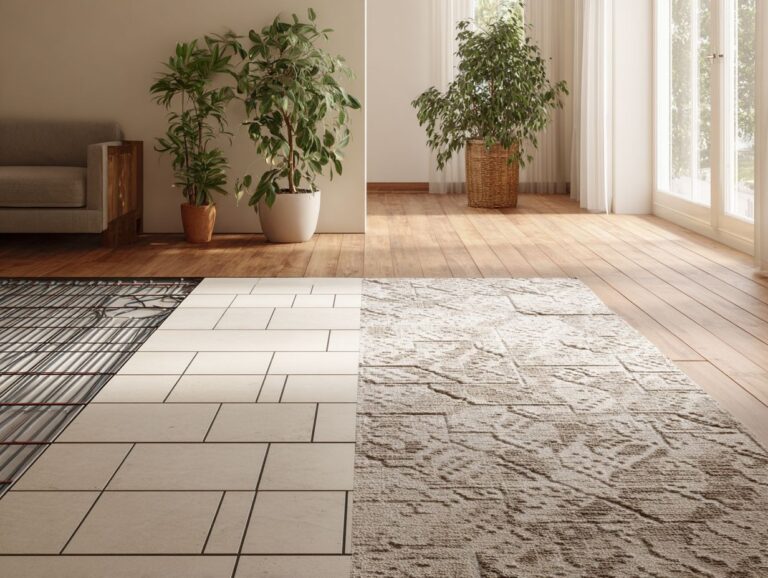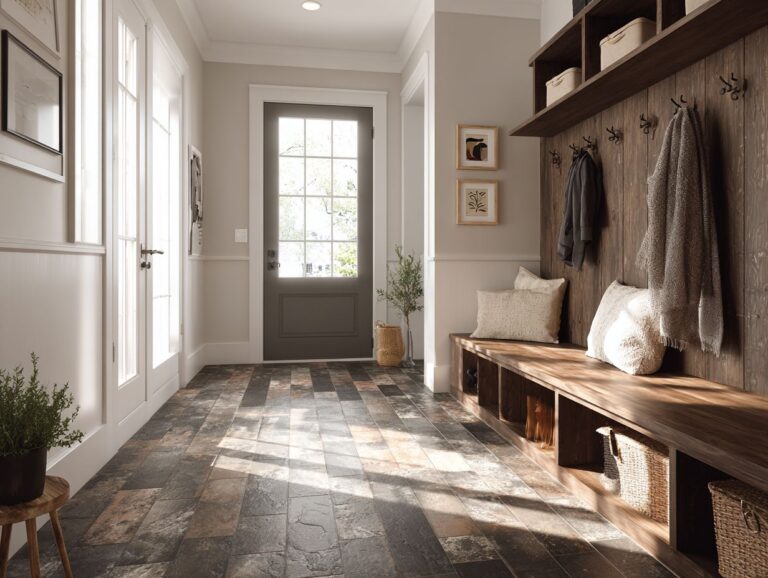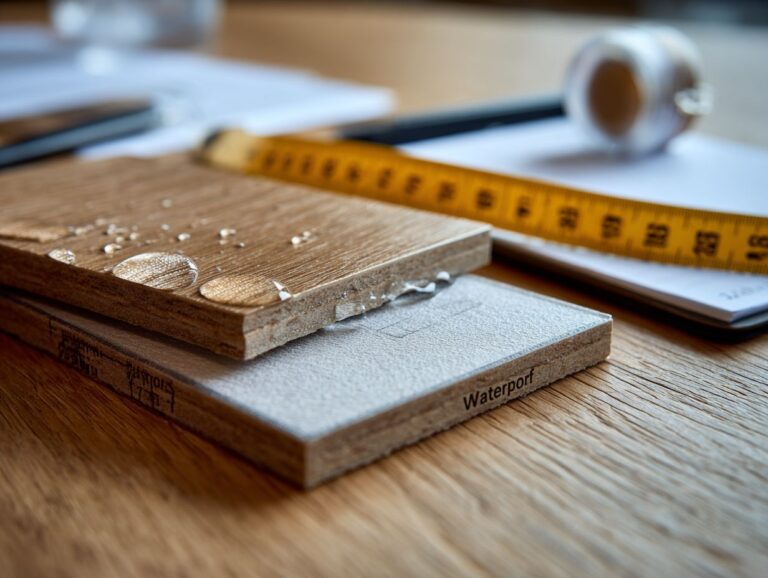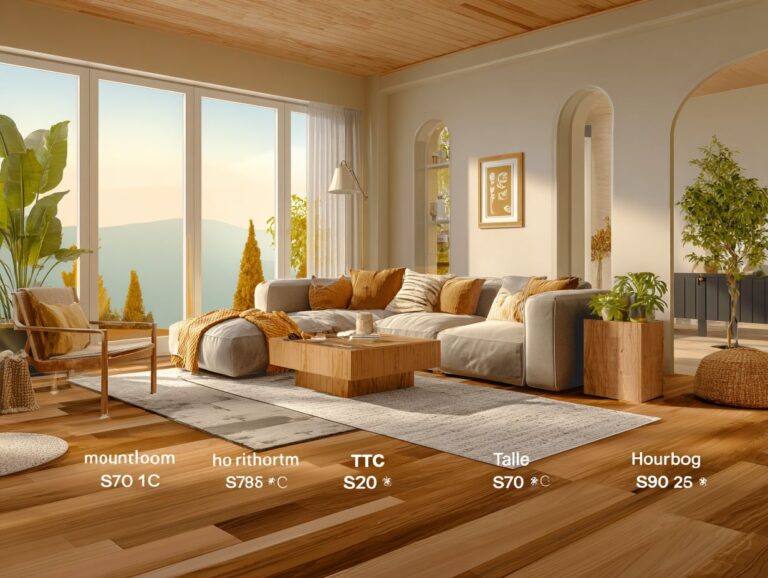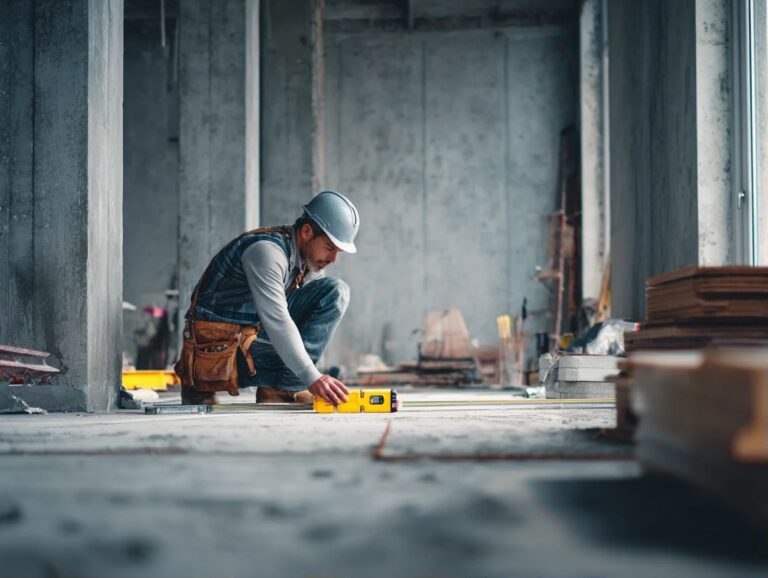Child-Safe Flooring – Cushioning and Cleanliness
Contents
- Introduction to Child-Safe Flooring
- Types of Child-Safe Flooring
- Cushioning in Child-Safe Flooring
- Cleanliness and Maintenance
- Child-Safe Flooring and Phthalate Exposure Statistics
- Installation Considerations
- Long-Term Benefits of Child-Safe Flooring
- Resources and Further Reading
- Frequently Asked Questions
- 1. What is child-safe flooring and why is it important?
- 2. What types of flooring are considered child-safe?
- 3. How does cushioning in flooring benefit children?
- 4. How can I keep child-safe flooring clean?
- 5. Are there any potential health concerns with child-safe flooring?
- 6. Are there any additional features I should look for in child-safe flooring?
Introduction to Child-Safe Flooring
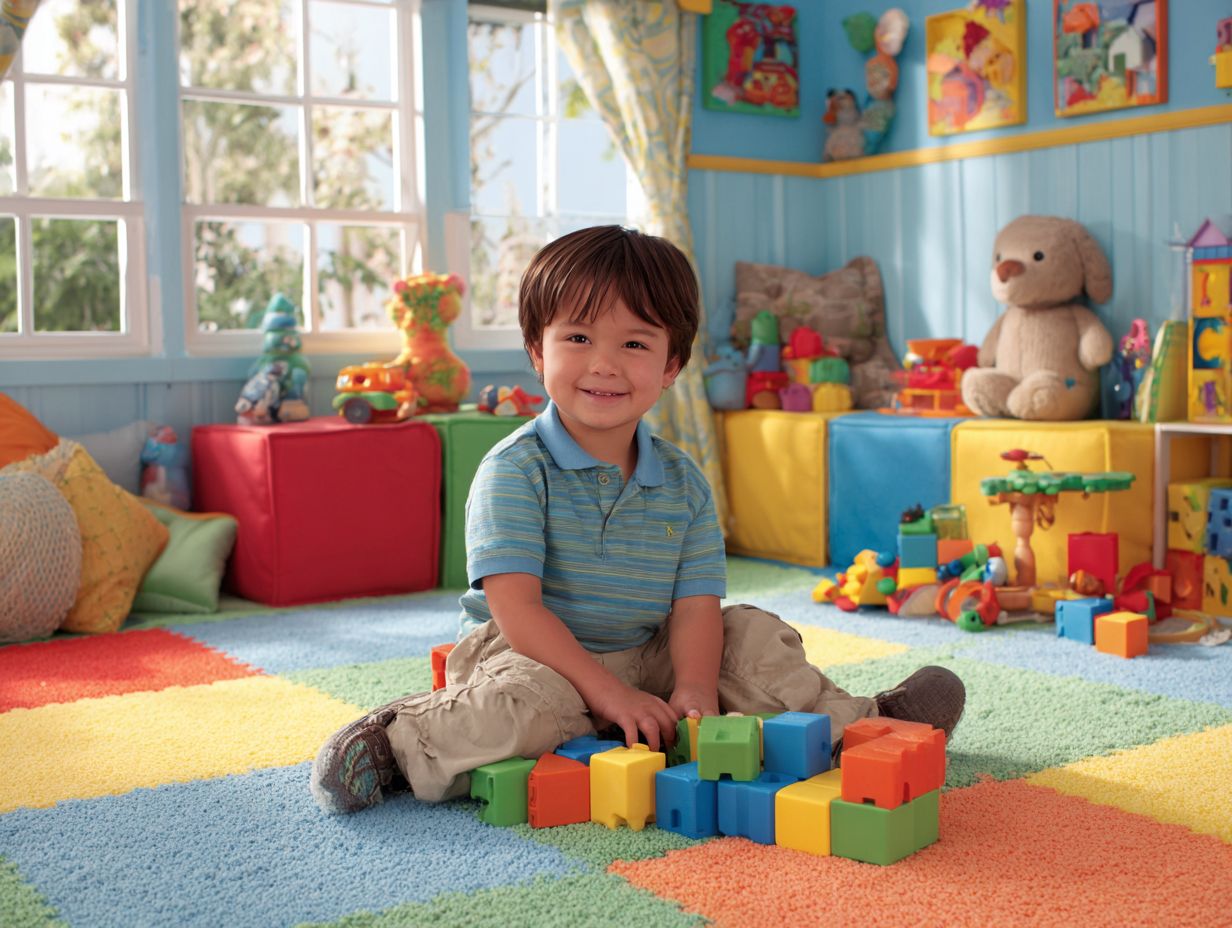
Key Takeaways:
Importance of Flooring in Child Safety
Flooring is very important for child safety, especially in play areas where there is a high chance of slipping and falling.
Utilizing flooring materials with features such as impact absorption and non-slip surfaces can significantly mitigate injury risks. For instance, rubber flooring is ideal for play areas, providing cushioning and reducing the likelihood of injuries, while also offering excellent traction.
Statistics show that around 8,000 children are treated for fall-related injuries daily in the U.S., underscoring the importance of safe flooring. Parents and caregivers should prioritize materials like cork or foam tiles, which combine comfort with safety, creating environments where children can play freely without excessive injury risk.
Overview of Cushioning and Cleanliness
Cushioning materials must be gentle for children and simple to clean and keep sanitary over time.
Rubber flooring is a top choice for areas prone to spills, as it can be wiped down effortlessly and is water-resistant.
Foam mats provide great padding and often come in bright colors. Make sure they have a cover you can remove for easy cleaning.
For outdoor spaces, consider artificial grass, which cushions falls while allowing for easy drainage and minimal maintenance.
By selecting materials that are both comfortable and practical, you create a safe environment that remains clean and inviting. For an extensive analysis of this trend, our comprehensive study of hypoallergenic flooring options explores how these choices can also benefit those with allergies.
Types of Child-Safe Flooring
Knowing the different kinds of flooring that are safe for children helps parents choose the best options for their kids’ needs and likes.
Soft Flooring Options
Soft flooring options like foam mats and gym mats are ideal for play areas, offering cushioning and safety during active play.
Choices that many people like are Greatmats interlocking foam tiles ($2.50 per square foot), praised for being simple to install and having bright colors. These tiles create a seamless surface, perfect for both home and school settings.
Another option is rubber gym flooring, such as BalanceFrom pads ($1.99 per square foot), which provide superior durability but can be heavier to install. While foam mats are softer, rubber options deliver longer-lasting performance ideal for high-traffic areas.
Assess your specific needs, including budget and installation effort, to find the perfect soft flooring solution.
Hard Flooring Options
Vinyl and laminate floors are long-lasting and easy to clean, which makes them good choices for places with a lot of foot traffic.
Luxury vinyl plank (LVP) flooring stands out for its water resistance and realistic wood appearance, priced around $2 to $5 per square foot. It’s ideal for kitchens and bathrooms, where spills are common.
On the other hand, laminate flooring, costing approximately $1 to $3 per square foot, offers a wide range of designs but is less resistant to moisture. For those interested in the various options, textured laminate flooring options such as hand-scraped, embossed, and smooth styles provide both aesthetic appeal and practicality.
Both choices are simple to keep clean, usually just requiring regular sweeping and occasional mopping, making them good for busy households.
When choosing, consider the room’s moisture levels and your budget.
Comparative Analysis of Materials
A comparative analysis of various flooring materials helps identify which options best meet safety, comfort, and environmental standards.
For example, cork flooring is effective at reducing noise and decomposes naturally, making it environmentally friendly. On the other hand, rubber flooring prevents slipping effectively and is often used in gyms and play areas.
Cork flooring usually costs between $3 and $8 per square foot, while rubber flooring is generally priced from $2 to $7.
When considering maintenance, cork generally requires periodic sealing to prevent moisture damage, while rubber is more resilient and easier to clean. Looking at these traits helps you make a well-informed decision.
Cushioning in Child-Safe Flooring
Adding proper padding to floors where children play makes it much safer by lowering the chance of getting hurt from falls.
Benefits of Cushioning for Children
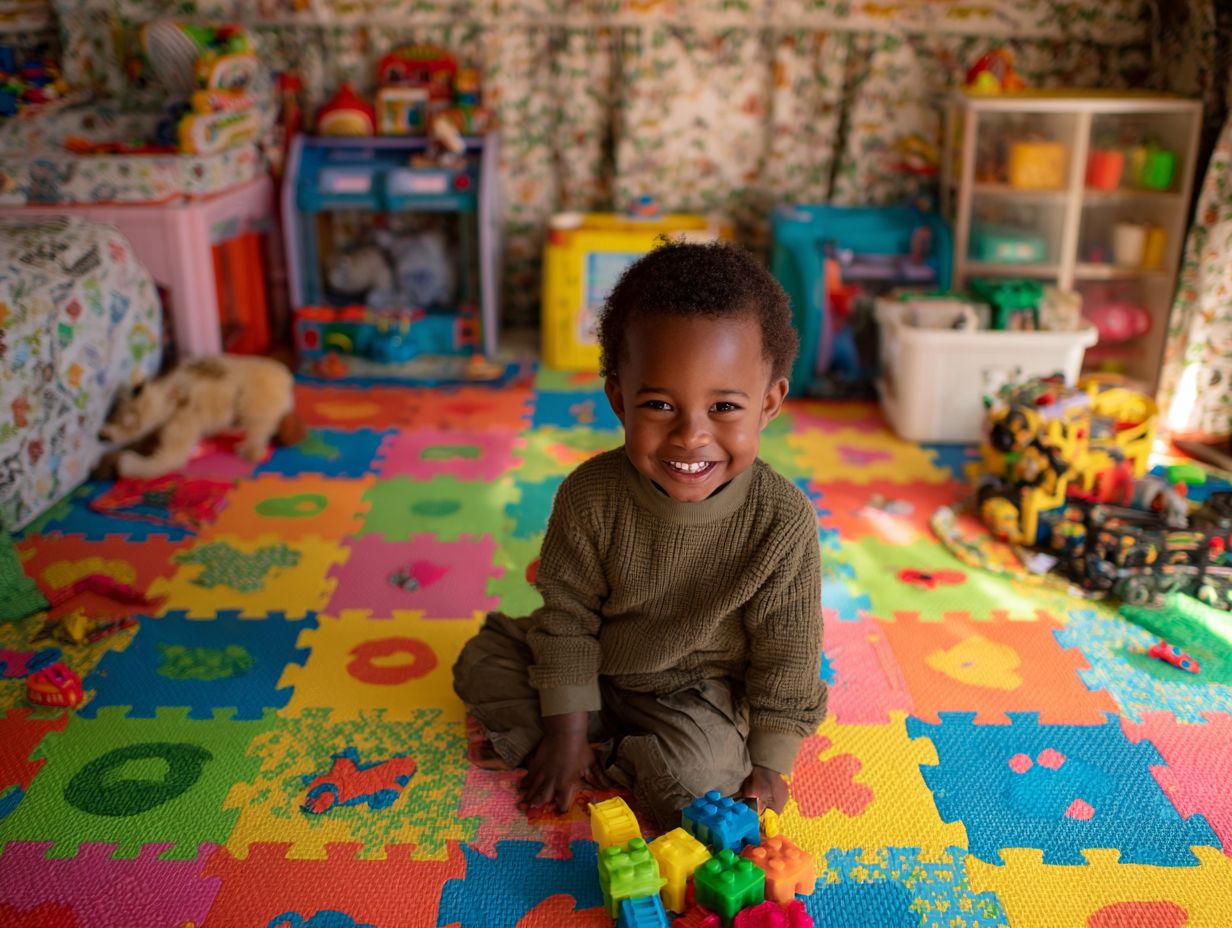
Padding in flooring can reduce injury risk by absorbing impact, making it important for areas meant for children.
Studies indicate that soft flooring options, such as foam mats and carpet tiles, contribute significantly to child safety. For instance, a 2019 study found that foam mats reduced the risk of head injuries by over 50% during falls.
Cushioning provides comfort during play, encouraging physical activity and creativity. To improve safety, think about buying interlocking foam tiles. They cushion well against impacts and are simple to clean.
These flooring choices provide comfort and safety, allowing children to move around and play with less chance of getting hurt.
Materials Providing Optimal Cushioning
Materials like durable rubber and foam mats offer great cushioning, making them ideal choices for children’s play areas.
Other excellent options include interlocking foam tiles, which provide customizable coverage and are easy to clean.
Products like the BalanceFrom Puzzle Exercise Mat do not absorb water and provide good cushioning, which makes them ideal for active play.
Consider using soft synthetic turf, such as the SynLawn Kids Playground Turf, which is designed for safety and can withstand outdoor conditions.
All these materials often meet ASTM safety standards, ensuring they protect children from falls while enhancing their play experience.
Impact Resistance and Safety Ratings
Checking how well flooring holds up against impacts and its safety scores helps confirm it can handle falls common in areas where kids play.
- Key certifications to look for include ASTM F1292, which tests the impact attenuation of playground surfaces, and ASTM F1951, assessing accessibility.
Flooring materials like rubber tiles, engineered wood, and cushioned vinyl are great options because they frequently meet these high standards.
- For rubber tiles, brands like Ecore and Ninex have high ratings, while Shaw’s cushioned vinyl is known for its resilient properties.
Having these certifications for your flooring increases safety and offers reassurance to parents and caretakers.
Cleanliness and Maintenance
Keeping child-safe floors clean is important for a healthy space without allergens and germs.
Choosing Non-Toxic Flooring Materials
Choosing safe flooring materials is important for protecting children’s health, especially in areas where they spend a lot of time.
Two excellent choices are cork and luxury vinyl. Cork naturally prevents the growth of bacteria and mold, so it’s a safe choice for playrooms or nurseries. Look for products certified by Greenguard, ensuring low emissions of harmful chemicals.
Luxury vinyl, particularly those with no added phthalates or VOCs, offers durability and easy maintenance while being visually appealing. When shopping, verify certifications like FloorScore, which also guarantees indoor air quality.
Both materials provide security and style, giving you confidence while improving the look of your home. For a more sustainable cleaning routine that complements these eco-friendly materials, explore green cleaning solutions for all flooring types.
Child-Safe Flooring and Phthalate Exposure Statistics
Child-Safe Flooring and Phthalate Exposure Statistics
Phthalate Exposure and Flooring Type: Phthalate Concentrations
Phthalate Exposure and Flooring Type: Urinary Metabolite Concentrations
The dataset on Child-Safe Flooring and Phthalate Exposure Statistics offers important information on how various flooring materials affect phthalate levels indoors. This data is particularly important for assessing health risks associated with phthalate exposure, especially for children who are more vulnerable to these chemical compounds.
Phthalate Exposure and Flooring Type examines the presence of Benzyl butyl phthalate (BBzP), a common phthalate used in vinyl and linoleum flooring. The data reveals that indoor air BBzP concentrations are significantly higher, at 23.9 g/m, in environments with vinyl or linoleum flooring compared to 10.6 g/m with wood or carpet flooring. The noticeable difference shows how flooring materials affect air quality. Vinyl and linoleum increase phthalate levels indoors.
Further, the analysis of urinary metabolite concentrations indicates that children in homes with vinyl or linoleum flooring have higher levels of BBzP metabolites, at 32.6 g/g, compared to 18.3 g/g for those with wood or carpet flooring. This suggests a direct correlation between flooring type and the extent of phthalate exposure in children. Exposure is worrying because phthalates are connected to breathing problems, allergies, and hormonal changes, especially in kids who are still growing.
- Higher amounts of phthalates found in vinyl and linoleum floors are a reason to pick safer options such as wood or carpet. This can help limit exposure, especially in homes with young kids.
- Parents and caregivers should be aware of the potential health risks and consider these statistics when selecting flooring materials for child-rich environments.
Overall, this dataset emphasizes the need for awareness about indoor air quality and the materials contributing to phthalate exposure. By choosing flooring types with lower phthalate emissions, families can create healthier indoor environments, minimizing risks associated with these harmful chemicals.
Cleaning Methods for Child-Safe Flooring
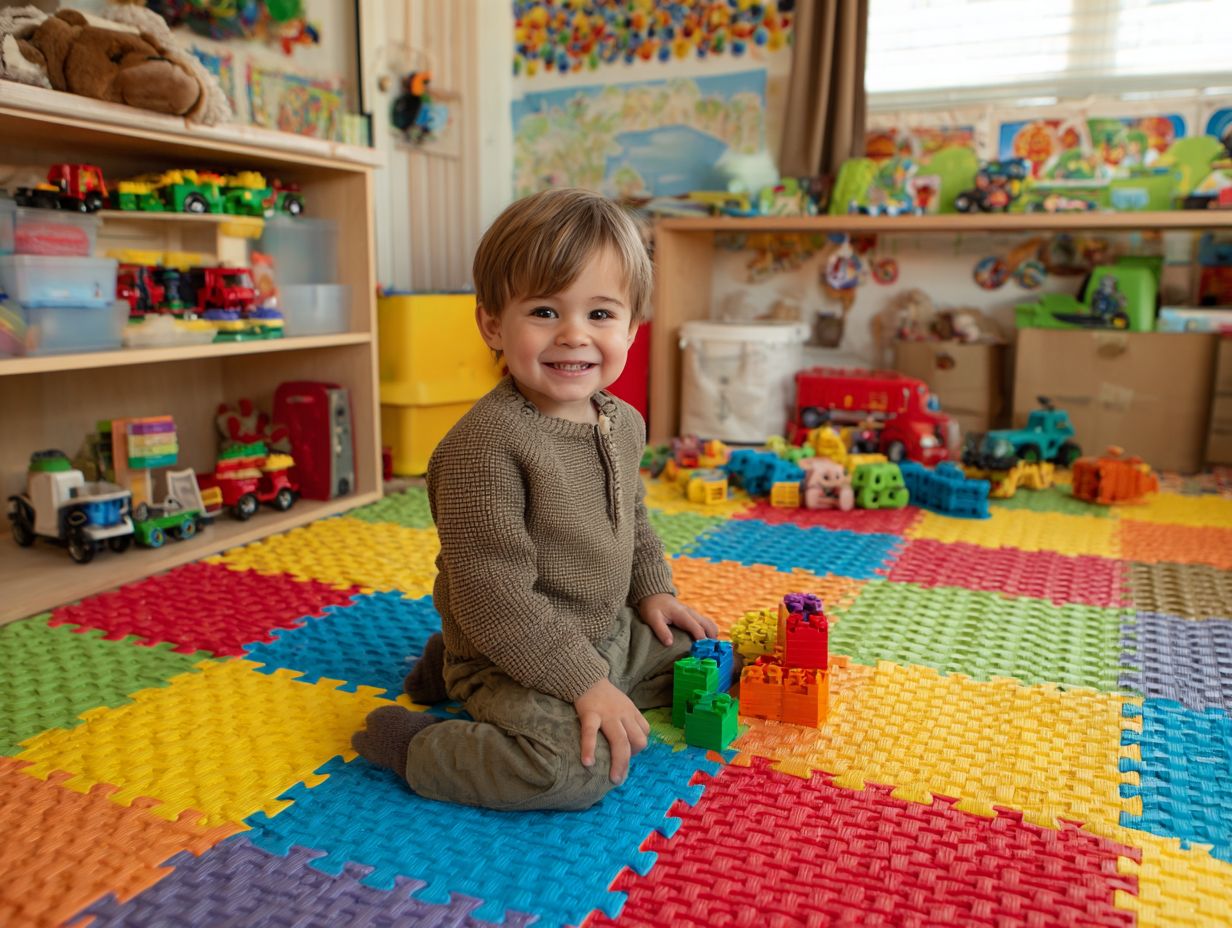
Using good cleaning practices keeps child-safe floors durable and clean.
To clean different kinds of flooring properly, follow these specific steps:
-
For hardwood, use a soft microfiber mop with a solution of warm water and a few drops of non-toxic dish soap.
-
To clean tile, use a blend of vinegar and water to remove dirt, and make sure to dry it well to avoid slipping.
-
For carpet, vacuum regularly and spot-clean with a mix of water and vinegar for stains.
Machines like the Bissell CrossWave offer versatility, handling both hard floors and carpets. Clean areas with a lot of foot traffic once a week for best results.
Preventing Allergens and Bacteria
Consistent cleaning and using suitable materials can stop allergens and bacteria from building up in areas where children spend time.
Implementing strategies to minimize allergens starts with selecting hypoallergenic materials, such as organic cotton bedding and non-toxic paint.
It’s important to clean regularly. For instance, vacuum carpets every week using a vacuum with a HEPA filter to capture tiny particles. Consider air purifiers with HEPA filters, especially in bedrooms, to reduce airborne allergens.
According to the Asthma and Allergy Foundation, up to 50 million Americans suffer from allergies, underscoring the importance of a clean environment. Regular washing of stuffed toys and furniture upholstery can further reduce allergen accumulation.
Installation Considerations
When putting in flooring safe for children, knowing your installation choices can help you save time and get great results.
Professional vs. DIY Installation
Deciding between professional installation and DIY can impact both the budget and the quality of the final flooring result.
Professional installation typically ranges from $2 to $6 per square foot, depending on the material and complexity. While this guarantees skill and a smooth result, it needs more money.
Doing the installation yourself can be cheaper, but you need to know how to measure and cut materials correctly. Tools like a miter saw, chalk line, and floor nailer are essential for a successful job.
If you enjoy home improvement projects, you can find online tutorials to guide you through the process, simplifying tasks for homeowners.
Cost Factors and Budgeting
Knowing the different cost elements allows parents to plan realistic budgets for flooring projects that are safe for children.
For a 500 sq ft play area, consider the following flooring options:
- Carpet Tiles ($1.50/sq ft): Offers comfort but requires more maintenance. Cost: $750.
- Vinyl Flooring ($2/sq ft): Durable and easy to clean. Cost: $1,000.
- Foam Mats ($3/sq ft): Excellent for safety and cushioning. Cost: $1,500.
- Cork Flooring ($5/sq ft): Eco-friendly but pricier. Cost: $2,500.
Factor in installation costs (ranging from $0.50 to $3 per sq ft) and ongoing maintenance. Choosing durable, easy-to-clean materials can save money long-term.
Long-Term Benefits of Child-Safe Flooring
Putting in child-safe flooring improves safety right away and supports children’s growth and health over time.
Durability and Longevity
Long-lasting flooring is perfect for busy families and places with a lot of foot traffic.
Consider materials like hardwood, which can last 50 years or more when properly maintained, or luxury vinyl planks (LVP) that offer a lifespan of 25 years and resist scratching.
Tile flooring, especially porcelain, is another long-lasting option, often exceeding 50 years. Each of these materials makes your home last longer and look better.
When choosing flooring, check for warranties that show how long the product will last and talk to experts for correct installation, which can make your floor last much longer.
Impact on Child Development
High-quality flooring can greatly affect a child’s physical development and safety while playing, creating a better setting for growth.
Studies indicate that soft flooring materials, like foam tiles and carpets, can lower the chance of injuries from falls, which is important when children are in their phase of exploring.
For instance, a study published in the Journal of Pediatrics found that children playing on cushioned surfaces experienced fewer injuries compared to those on hard surfaces.
Using textured floors, such as rubber or cork, can improve sensory experiences and help develop motor skills.
These choices encourage active play while ensuring a safer space for developmental milestones.
Recap of Key Points
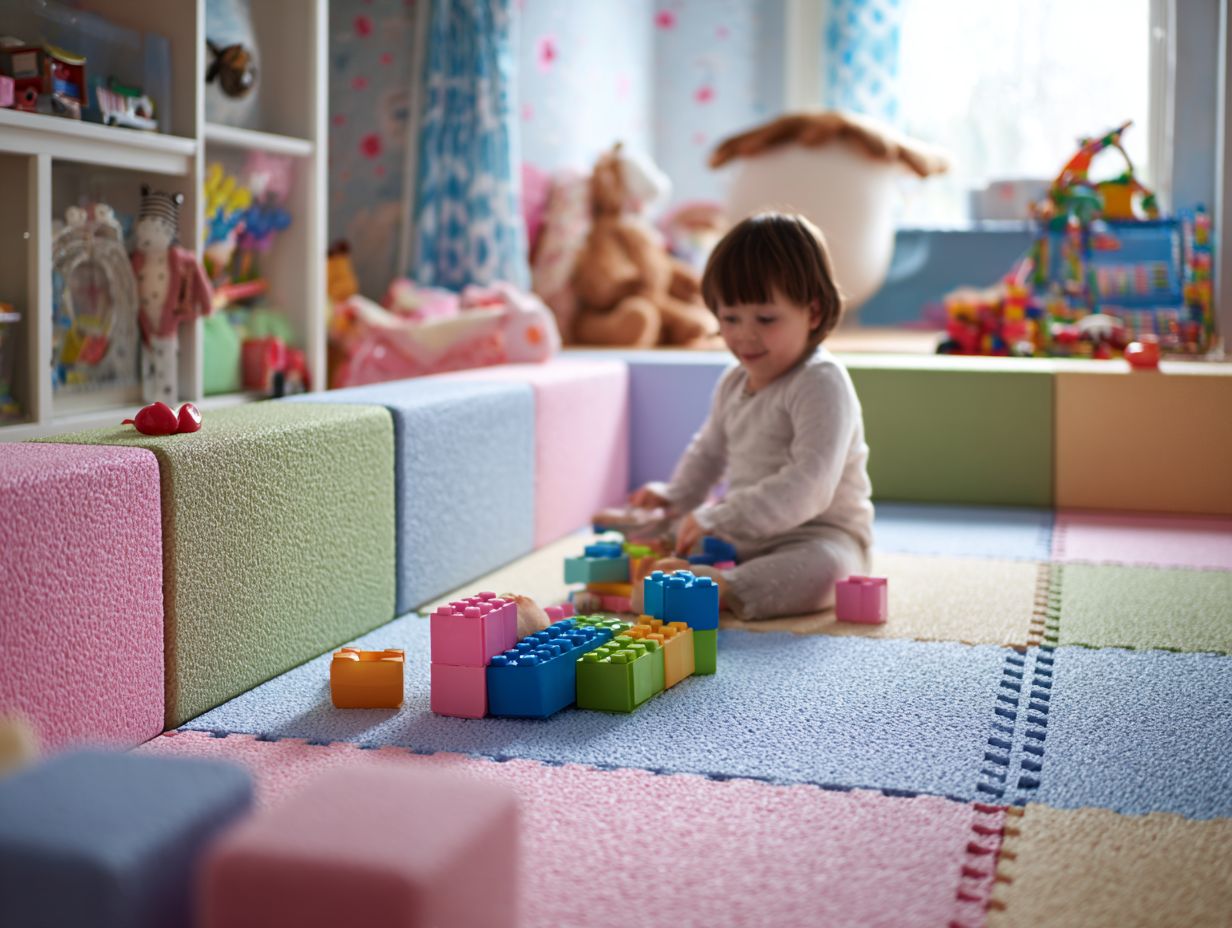
Reviewing the key points about flooring that’s safe for children emphasizes the need to make well-thought-out choices.
When choosing flooring, consider options like cork, rubber, and carpet.
- Cork is a soft material that absorbs impacts, making it ideal for playgrounds.
- Rubber flooring is waterproof and anti-slip, perfect for high-traffic zones.
- Meanwhile, carpet offers cushioning and warmth but may require regular cleaning.
Always check for safety certifications like FloorScore or Greenguard, which guarantee low levels of harmful chemicals.
Regular upkeep is important: clean surfaces regularly, remove any debris, and fix damage quickly to avoid accidents.
Final Recommendations for Parents
To provide the best for your children, choose flooring that is safe, lasts a long time, and is easy to clean.
Consider materials like cork, which is soft and warm, perfect for play areas, or bamboo, known for its sustainability and hardness.
Ask suppliers about the safety certifications of their products, particularly those that are free from harmful chemicals.
Ask about the warranty and how long the flooring will last. Luxury vinyl plank is durable and can withstand heavy foot traffic and liquid spills, making it a suitable option for busy homes.
Evaluate the ease of cleaning; materials like tile or sealed hardwood can be simply wiped down, minimizing hassle while keeping your children safe.
Resources and Further Reading
For detailed information on child-safe flooring, check out these selected resources and articles.
These resources will help you understand different flooring options and safety standards.
The Consumer Product Safety Commission (CPSC) provides guidelines on what constitutes safe materials for children’s spaces.
Websites like Safe Kids Worldwide offer articles on the importance of flooring safety and recommendations.
For specific product reviews, check out Good Housekeeping’s list of the best child-safe flooring types, such as cork and rubber, highlighting their durability and non-toxicity.
Looking into these resources will help you make well-informed choices for a more secure environment.
Frequently Asked Questions
1. What is child-safe flooring and why is it important?
Flooring that is safe for young children means it doesn’t pose any risks while they play. It is important because children spend a lot of time playing on the floor and it should be a safe and clean environment for them.
2. What types of flooring are considered child-safe?
Child-safe flooring includes materials such as cork, rubber, and carpet with low pile or padding. These materials provide cushioning and absorb impact, reducing the risk of injury for children.
3. How does cushioning in flooring benefit children?
Cushioning in flooring offers a soft surface for children to play on, reducing the impact on their joints and preventing injuries. It also provides a comfortable surface for crawling, sitting, and playing.
4. How can I keep child-safe flooring clean?
Regular cleaning and maintenance are key to keeping child-safe flooring clean. Vacuuming, mopping, and spot cleaning spills and messes immediately can help maintain a hygienic environment for children to play on.
5. Are there any potential health concerns with child-safe flooring?
Most child-safe flooring materials are non-toxic and do not emit harmful chemicals. However, be sure to research and choose flooring materials that are confirmed to be safe for children, particularly those with allergies or sensitivities.
6. Are there any additional features I should look for in child-safe flooring?
In addition to cushioning and cleanliness, child-safe flooring should also have good slip resistance to prevent falls. It is also beneficial to choose flooring that is easy to maintain and durable, as children can be messy and rough on floors.
